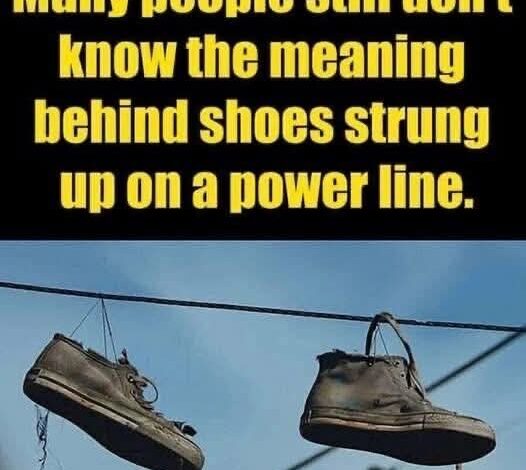
The Meaning Behind Shoes Strung Up On A Power Line
It’s a sight many people recognize: sneakers dangling from overhead wires, swaying gently with the breeze. Though less common today than in past decades, the image of shoes strung across power lines still sparks curiosity, urban myths, and cultural debate. What does it mean? Why do people do it? And how did this peculiar act become part of public imagination?
Historic Origins
One theory traces the act back to soldiers marking a milestone. Some say the tradition began when servicemen tossed their boots onto wires to celebrate the completion of military service. Hanging the boots symbolized both an ending and a new beginning—a way of leaving one chapter behind while stepping into the next. In certain communities, this ritual spread, eventually becoming detached from its original meaning and absorbed into broader youth culture.
Gang Symbolism and Urban Legends
Another widely circulated belief is that sneakers on wires signify gang activity or drug territory. Movies, crime dramas, and word-of-mouth have cemented this idea in popular consciousness. The narrative suggests that shoes mark turf boundaries or point to places where drugs can be bought. However, law enforcement agencies and researchers have largely dismissed this theory as exaggerated or anecdotal. While shoes on wires might occasionally intersect with crime, the broader evidence indicates it is more often mischief than menace.
Bullying, Dares, and Pop Culture
Pop culture has reinforced the association between dangling sneakers and bullying. Films and TV shows have depicted scenes where a bully steals someone’s shoes and flings them out of reach, leaving the victim humiliated. While this portrayal adds drama, it is not strongly supported by widespread data. Still, the visual stuck, helping sneakers-on-wires become shorthand for youthful conflict, rebellion, or pranks in storytelling.
For teenagers, the act often had less to do with malice and more to do with dares, boredom, or attention-seeking. Like graffiti, skateboarding tricks, or other forms of youthful mischief, tossing sneakers onto wires became a small act of defiance against ordinary order.
Mischief and Youth Culture
In reality, many cases of shoes on wires boil down to playful mischief. Young people—often in groups—may treat the act as a challenge, laughing as they see who can sling the shoes high enough for them to stay. The sneakers themselves might be old, unwanted, or taken as a trophy from a dare. For others, the appeal is simply the visibility: unlike a private joke, sneakers on wires create a public statement, one that hangs overhead for weeks or months.
Cultural Expression
Over time, sneakers on power lines gained layers of cultural meaning. In some neighborhoods, they came to represent local identity, rebellion, or even an accidental form of street art. The dangling shoes—silhouetted against the sky—can create striking images that artists and photographers have captured as symbols of urban grit.
In certain communities, residents embraced the shoes as a marker of character, much like murals or tags on walls. Others resented them, seeing them as an eyesore or sign of neglect. This tension mirrors the way many forms of street culture are interpreted: either dismissed as vandalism or elevated as cultural expression.
Safety Concerns
Beyond symbolism, utility companies warn that throwing shoes onto power lines poses genuine risks. The weight of sneakers can damage lines, disrupt electrical systems, or complicate repairs. Utility workers tasked with removing them face hazards as they navigate live wires to safely cut the shoes down.
In some areas, particularly where the practice was widespread, authorities launched campaigns discouraging it. Schools and community groups stressed that while the act may seem harmless, it can interfere with essential infrastructure and put workers at risk.
Better Alternatives
Rather than tossing old sneakers into the sky, experts encourage recycling or donating them. Athletic shoe companies, environmental organizations, and community charities often accept used sneakers to be refurbished, repurposed, or broken down into materials for playground surfaces and athletic tracks. Donating shoes not only avoids waste but also supports those in need—offering a more meaningful legacy than dangling on a wire.
The Fascination Endures
Despite campaigns against the practice, the mystery of sneakers on power lines continues to capture public imagination. Passersby often pause, wondering who threw them, why they’re there, and what story they might tell. Photographers frame them as symbols of fleeting youth, rebellion, or transition. Storytellers use them as shorthand for gritty neighborhoods, troubled teens, or the beauty of randomness in public spaces.
Final Thoughts
The sight of shoes strung up on power lines may carry different meanings depending on who you ask. For some, it’s a relic of military tradition; for others, an urban legend about gangs. For many, it’s simply mischief, cultural expression, or a marker of local flavor. What’s certain is that the image has transcended its act, becoming part of the broader cultural landscape.
Yet beneath the curiosity and symbolism lies a simple truth: the practice is dangerous, and better alternatives exist. Donating, recycling, or repurposing sneakers is safer, more sustainable, and more impactful. Still, the next time you see shoes dangling overhead, you may find yourself pausing to wonder—are they a prank, a memory, or an unspoken message left to the sky?




